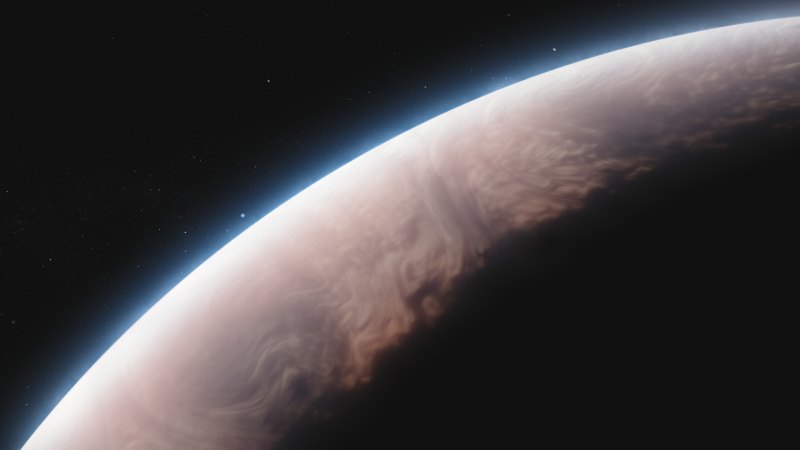Researchers have made a groundbreaking discovery using NASA’s James Webb Space Telescope, detecting evidence of quartz nanocrystals within the high-altitude clouds of WASP-17 b, a scorching exoplanet located 1,300 light-years away from Earth. This remarkable detection, made possible by Webb’s Mid-Infrared Instrument (MIRI), signifies the first-ever spotting of silica (SiO2) particles in an exoplanet’s atmosphere.
David Grant, a researcher at the University of Bristol in the UK and the first author of a forthcoming paper in the Astrophysical Journal Letters, expressed his excitement, stating, “We were thrilled! We knew from Hubble observations that there must be aerosols—tiny particles making up clouds or haze—in WASP-17 b’s atmosphere, but we didn’t expect them to be made of quartz.”
While silicates, minerals rich in silicon and oxygen, are abundantly found in Earth, the Moon, and other celestial bodies in our solar system, as well as throughout the galaxy, the silicate grains previously identified in exoplanet and brown dwarf atmospheres were primarily magnesium-rich silicates like olivine and pyroxene. The discovery of quartz alone, pure SiO2, in WASP-17 b’s atmosphere challenges our understanding of how exoplanet clouds form and evolve.
WASP-17 b, with a volume over seven times that of Jupiter and less than half its mass, is one of the largest known exoplanets, characterized by a brief orbital period of merely 3.7 Earth days. This makes it an ideal candidate for transmission spectroscopy, a technique used to measure the interaction of a planet’s atmosphere with starlight.
Webb observed the WASP-17 system for nearly ten hours, collecting a plethora of brightness measurements in the 5- to 12-micron mid-infrared range as the planet transited its star. By subtracting the brightness of individual wavelengths of light when the planet crossed in front of the star from those of the star alone, the researchers calculated the amount of each wavelength blocked by the planet’s atmosphere.
What emerged from this data was an unexpected “bump” at 8.6 microns, a feature that defied expectations if the clouds were composed of magnesium silicates or other potential high-temperature aerosols, such as aluminum oxide, but was entirely consistent with the presence of quartz.
These quartz crystals, while possibly resembling the hexagonal prisms found in geodes and gem shops on Earth, are incredibly small, measuring about 10 nanometers across, a millionth of a centimeter.
Nikole Lewis of Cornell University, a co-author and leader of the Webb Guaranteed Time Observation program, explained the crucial role of Hubble data in determining the size of these particles. These quartz crystals are not sourced from a rocky surface like the mineral particles in Earth’s clouds. They originate within the planet’s scorching atmosphere where conditions, at around 1,500 degrees Celsius (2,700°F) and significantly reduced pressure compared to Earth, allow solid crystals to form directly from gas.
Understanding the composition of the clouds is pivotal in comprehending the planet as a whole. Hot Jupiters, like WASP-17 b, are predominantly composed of hydrogen and helium, with traces of other gases like water vapor (H2O) and carbon dioxide (CO2). Neglecting to account for the oxygen within minerals like quartz would lead to a significant underestimation of the total abundance. These silica crystals provide insights into the variety of materials and their roles in shaping the planet’s environment.
The extent and prevalence of these quartz clouds are difficult to ascertain, but they are likely to exist along the day/night transition, or the terminator, where observations were concentrated. Given the planet’s tidal locking and extreme temperature differences between its day and night sides, these clouds are likely in constant motion, possibly driven by high-speed winds.
WASP-17 b is one of three planets selected for the Deep Reconnaissance of Exoplanet Atmospheres using Multi-instrument Spectroscopy (DREAMS) investigations, led by the JWST-Telescope Scientist Team. These investigations aim to provide a comprehensive set of observations of key classes of exoplanets: a hot Jupiter, a warm Neptune, and a temperate rocky planet. The MIRI observations of hot Jupiter WASP-17 b were carried out as part of GTO program 1353.
The James Webb Space Telescope is a global space science observatory, addressing questions about our solar system, exploring distant exoplanets, and delving into the mysteries of the universe’s structure and origins. It is a collaborative program led by NASA, in partnership with the ESA (European Space Agency) and the Canadian Space Agency.
The information contained in this post is for general information purposes only. The information is provided by James Webb Space Telescope Discovers Minute Quartz Crystals Within Atmosphere of Hot Gas Giant and while we endeavour to keep the information up to date and correct, we make no representations or warranties of any kind, express or implied, about the completeness, accuracy, reliability, suitability or availability with respect to the website or the information, products, services, or related graphics contained on the post for any purpose.


